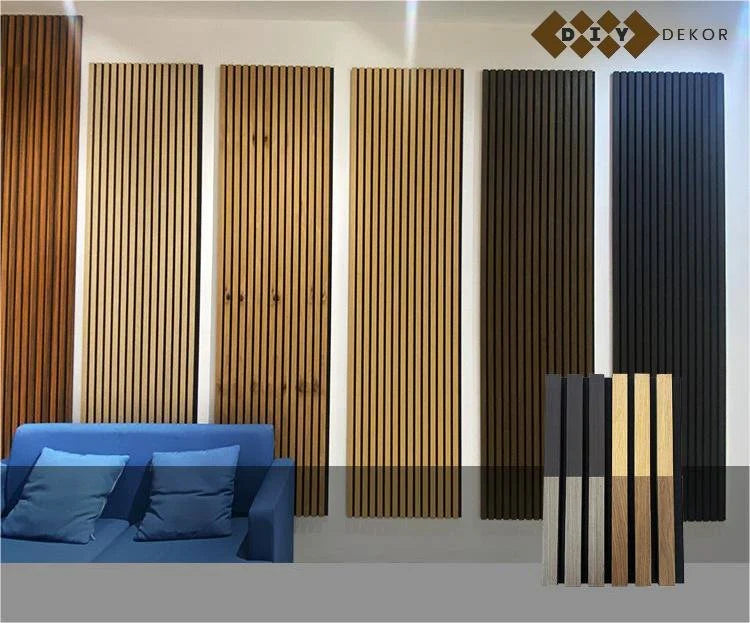(877) 358-5731
Monday-Friday: 10am-6pm EST

Why Choose Wood Paneling For Your Home Interior
Wood paneling has long been recognized for its capacity to transform spaces, bringing a sense of warmth and sophistication to any interior. This material is available in a variety of types and styles, making it an excellent option for your home.
Whether you are looking to create inviting statement walls or seeking durability and versatility, wood paneling can enhance your interior design while remaining budget-friendly.
Discover how to effectively integrate this timeless material into various areas of your home for impressive results.
What is Wood Paneling?
Wood paneling serves as a versatile and timeless architectural feature that enhances the aesthetic appeal of various spaces, including homes, offices, and garden rooms. It involves the installation of wooden panels on walls, offering both functional and decorative benefits.
This material is celebrated not only for its beautiful natural aesthetics and warmth but also for its durability and acoustic properties, making it a favored choice among DIY enthusiasts and interior designers.
Whether you prefer traditional or modern styles, wood paneling can transform any space while providing excellent insulation and contributing to energy cost reduction.
What Types of Wood are Used for Paneling?
There are various types of wood available for paneling, each presenting unique characteristics and benefits such as durability, aesthetic appeal, and sustainability. You can choose from solid woods like American Oak and American Walnut, which are renowned for their visual impact and long-lasting performance. Engineered materials like MDF are also popular due to their cost-effectiveness and versatility, making them an excellent option for homeowners seeking to enhance their interior design with beautiful wood paneling.
Additionally, softwoods such as Pine and Cedar offer a warm, rustic charm while being lightweight and easy to work with, making them ideal for creating cozy spaces. Bamboo has also gained traction as an eco-friendly alternative, providing exceptional strength and a unique grain pattern that adds a contemporary touch.
It is essential to consider the maintenance requirements of each material; for example, while solid woods may need periodic refinishing, engineered products typically require less upkeep. Ultimately, selecting the right type of wood is crucial, as it not only dictates the overall aesthetic of a space but also ensures long-term performance and sustainability.
What are the Different Styles of Wood Paneling?
Wood paneling is available in a variety of styles to suit different tastes and design preferences, ranging from traditional to modern aesthetics. Popular options include Slatpanel, Braid Mosaic Wood Wall Panel, and Triangular Wood Wall Panel, each offering unique decorative elements and visual interest for any space. As a homeowner or interior designer, you may select these styles based on the atmosphere you wish to create, whether that’s a warm and cozy environment or a sleek and contemporary look.
For traditional themes, classic beadboard or shiplap styles can infuse spaces with a sense of timeless charm, making them ideal for rustic or farmhouse designs. In contrast, modern aesthetics often embrace minimalist options such as flat paneling or textured finishes, adding depth without overpowering the overall look.
Additionally, decorative options like geometric patterns or artistic murals serve as striking focal points, providing opportunities for greater customization that enhances architectural interest. For example, a Braid Mosaic Wood Wall Panel can establish a sophisticated backdrop in a living room, while Slatpanel can cleverly incorporate wall-mounted lighting or shelving, seamlessly merging functionality with stunning design.
Why Choose Wood Paneling for Your Home Interior?
Choosing wood paneling for your home interior offers numerous advantages that enhance both the aesthetic appeal and functionality of your space. One of the primary benefits is its capacity to add warmth and texture, creating a cozy atmosphere that transforms the overall feel of a room.
Furthermore, wood paneling is known for its durability, making it a long-lasting investment that can withstand wear and tear while effectively reducing energy costs through improved insulation. Its versatility in design also allows you to customize your spaces, making it an ideal choice for any interior design project.
1. Adds Warmth and Texture
Wood paneling significantly enhances the warmth and texture of any room, fostering an inviting and cozy atmosphere that is often desired in home interiors. The natural beauty of wood, characterized by its unique grains and finishes, contributes to a tactile quality that elevates the overall aesthetic of the space.
The type of wood selected, whether it be the rich, dark tones of walnut or the light, airy essence of pine, not only impacts the visual appeal but also sets the mood of the environment. Each variety brings its own tonal warmth and character, evoking feelings of comfort and relaxation.
The finish applied to the paneling—whether a glossy sheen or a matte appearance—plays a vital role in how light interacts with the surface, creating soft reflections that enhance the inviting nature of the room. Ultimately, wood paneling not only beautifies interior spaces but also creates a sensory experience that promotes well-being and fosters a sense of togetherness.
2. Durable and Long-lasting
Wood paneling is recognized for its durability and long-lasting performance, making it a valuable investment for homeowners aiming to enhance their interior spaces. With the right care and maintenance, wood paneling can endure the test of time, preserving its beauty and structural integrity for many years.
To ensure that the paneling remains visually appealing and functions effectively, regular cleaning and occasional refinishing are crucial steps. Homeowners should prioritize dusting the surface frequently and cleaning it with a mild soap solution to prevent the accumulation of grime. Additionally, applying a protective sealant can safeguard against moisture damage, which is particularly advantageous in areas susceptible to humidity.
When maintained properly, quality wood paneling not only elevates the aesthetic appeal of a room but also serves as a testament to the investment in one's home, providing both a stylish appearance and enduring value over the years.
3. Versatile Design Options
One of the standout features of wood paneling is its versatility in design options, allowing you to customize your spaces to fit your unique style and preferences.
With a wide array of finishes, textures, and colors available, you can easily find a wood paneling solution that resonates with your individual tastes. Whether you choose rustic reclaimed wood for a cozy, farmhouse vibe or sleek, polished panels for a contemporary look, these design choices can dramatically alter the ambiance of any room.
As a DIY enthusiast, you can also engage in projects that feature different layout patterns, such as herringbone or shiplap, further enhancing the aesthetic appeal. This level of customization not only elevates the overall design but also adds a personal touch, making each space feel uniquely inviting.
4. Easy to Install and Maintain
Wood paneling is well-regarded for its ease of installation, making it an excellent option for DIY enthusiasts and homeowners embarking on home improvement projects. Many wood paneling choices are designed to be maintenance-free, which simplifies the upkeep of these attractive installations.
This accessibility give the power tos individuals to transform their living spaces without relying on professional assistance, fostering a sense of achievement and personalization. With a wide array of styles, thicknesses, and finishes available, homeowners can readily find wood paneling that complements their existing decor, whether revitalizing a cozy den or enhancing a modern kitchen.
Installation typically requires only basic tools and a bit of patience, and since the materials are usually lightweight, handling them is manageable. The combination of aesthetic benefits and convenience makes wood paneling a prudent choice for anyone looking to enhance their home efficiently and effectively.
5. Cost-effective Option
Wood paneling presents a cost-effective solution for homeowners seeking to enhance their interiors without substantial expenditure. It not only provides an aesthetic upgrade but also contributes to reduced energy costs through effective insulation, positioning it as a prudent investment for sustainable home improvements.
Plus its visual appeal, wood paneling yields significant long-term savings by enhancing energy efficiency within the home. Acting as a natural insulator, it helps maintain consistent temperatures, thereby reducing reliance on heating and cooling systems. This results in lower utility bills and a smaller carbon footprint, reinforcing its status as an environmentally friendly choice. The durability of high-quality wood paneling ensures that homeowners can avoid frequent repairs or replacements, leading to considerable financial savings over time.
Furthermore, its timeless charm has the potential to increase property value, attracting future buyers who appreciate both style and energy-conscious upgrades.
How to Incorporate Wood Paneling into Your Home Design?
Incorporating wood paneling into your home design can significantly enhance its visual appeal and atmosphere, providing a variety of options to match any style.
You have the opportunity to create a striking statement wall, utilize paneling as sophisticated accent pieces, or install it in specific areas such as wainscoting to add depth and character to your spaces.
1. Create a Statement Wall
Creating a statement wall with wood paneling is an effective way for you to make a bold design statement in any room. This technique draws the eye and serves as a focal point that enhances the overall aesthetic while adding depth and texture to your space.
By incorporating wood paneling, you can explore a myriad of styles, ranging from rustic farmhouse to sleek modern minimalism, tailoring each design choice to suit your taste. The variety of materials available, such as reclaimed wood, plywood, or engineered wood, allows for further customization, ensuring that your statement wall not only reflects your personal style but also harmonizes with the existing decor.
The choice of colors, finishes, and panel arrangement will contribute to the visual impact, resulting in a unique expression of creativity that transforms your environment into a stunning showcase of design ingenuity.
2. Use as Accent Pieces
Using wood paneling as accent pieces throughout your home can effectively complement your interior design while adding an element of decorative flair. These accent pieces can be strategically positioned to highlight architectural features or to create cozy nooks and inviting spaces.
When considering placement, it is advisable to apply paneling to a single wall or around a fireplace to create a focal point that draws the eye. Selecting the right type of wood and finish is crucial to enhancing the aesthetic qualities of your decor, whether you prefer a rustic appeal or a sleek, modern finish.
Incorporating shelving or artwork on top of the paneling can further enhance visual interest while providing functionality. Mixing different wood tones can add depth, and maintaining a balanced color palette will ensure that the overall design remains cohesive and stylish.
3. Install as Wainscoting
Installing wood paneling as wainscoting is an elegant way to enhance the lower portion of your walls while providing protection against wear and tear. This classic design feature adds sophistication and can transform any room into a more refined space.
Plus its aesthetic appeal, wood paneling offers exceptional durability, effectively shielding walls from scuffs and marks. This makes it an ideal choice for high-traffic areas such as hallways and dining rooms. The natural warmth of wood creates a cozy yet polished atmosphere, striking a perfect balance between style and function.
Maintenance is straightforward as well; a simple wipe-down is all it takes to keep the surfaces looking pristine, ensuring the beauty of the wood remains intact over time. This thoughtful investment not only elevates the visual quality of interiors but also enhances their longevity, making it a favored option among both homeowners and designers.
4. Mix and Match with Other Materials
Mixing and matching wood paneling with other materials can create a unique and dynamic design aesthetic that highlights your creativity and personal style. By combining wood with elements like metal, glass, or stone, you can craft visually engaging spaces that retain warmth and texture.
This approach not only enhances the overall style of your home but also encourages versatility in your design options. For example, sleek metal accents can introduce a contemporary vibe, while natural stone can evoke a rustic charm. Customization is essential; employing different finishes, colors, and textures allows you to express your individual taste.
Thoughtful combinations can break monotonous patterns, ensuring that each room feels inviting and exciting. The interplay between these materials leads to stunning focal points and cohesive designs that can easily adapt to various decor themes.
Where to Use Wood Paneling in Your Home?
Wood paneling can be effectively utilized in various areas of the home, each offering distinct benefits and enhancing the overall atmosphere. Whether in the living room, bedroom, kitchen, bathroom, or home office, wood paneling adds warmth and character, complementing a range of styles and functions.
1. Living Room
In the living room, wood paneling provides warmth and comfort, creating an inviting environment conducive to relaxation and social gatherings. This versatile material not only enhances aesthetic appeal but also contributes to the cozy atmosphere that many homeowners seek.
By incorporating wood paneling, you can easily introduce natural elements into your home decor, adding character and depth to the space. The rich textures and tones of wood complement a variety of design styles, from rustic to modern, offering you endless possibilities for personalization.
Additionally, wood boasts excellent acoustic properties, enhancing the comfort of your living room and making it an ideal setting for movie nights or intimate conversations. The use of paneling can create visual interest, drawing the eye and fostering a cohesive feel in the space, ultimately leading to a more inviting and stylish environment.
2. Bedroom
Incorporating wood paneling into your bedroom can create a cozy and tranquil atmosphere, making it the perfect retreat for relaxation. The natural beauty of wood contributes to a serene environment, allowing for a harmonious blend of style and comfort.
This timeless design choice not only enhances the aesthetic qualities of your space but also adds warmth that invites you to unwind after a long day. With various finishes and tones available, wood paneling can complement a wide range of interior themes, enabling you to personalize your retreat according to your tastes.
From rustic charm to modern elegance, the versatility of wood makes it an ideal choice for those seeking to establish a peaceful sanctuary. The texture of wood can create visual interest, enriching the overall design while fostering a calming atmosphere that rejuvenates the spirit.
3. Kitchen
Wood paneling in the kitchen not only enhances the overall design but also adds warmth and character to a space often dominated by cold surfaces. By incorporating wood elements, you can create a balanced and inviting atmosphere that is ideal for both cooking and entertaining.
High-quality wood paneling provides practical advantages, including durability and ease of maintenance, making it a wise choice for this high-traffic area. Unlike some materials that may chip or stain easily, well-finished wood can withstand the demands of daily use while preserving its aesthetic appeal.
With a wide variety of finishes and styles available, wood can seamlessly integrate into different design aesthetics, ranging from rustic to modern. This versatility enables you to personalize your space while ensuring that the kitchen remains functional, making wood paneling an excellent solution for those looking to combine style with practicality.
4. Bathroom
Incorporating wood paneling into the bathroom can create a spa-like retreat, providing a warm and inviting aesthetic that contrasts with traditional cold surfaces. This unique design choice has the potential to transform the space, significantly enhancing your overall experience of relaxation and comfort.
The natural beauty of wood introduces an organic element that fosters tranquility and a connection to nature. The rich textures and tones of wood can complement various design themes, from rustic to modern, making it a versatile option for any homeowner looking to elevate their personal sanctuary.
Beyond aesthetics, wood paneling offers excellent insulation, contributing to a cozy atmosphere while also helping to reduce noise. This thoughtful selection not only enhances the visual appeal but also cultivates an environment that encourages rejuvenation and calm, making each visit to the bathroom feel like a gentle retreat from the hustle and bustle of daily life.
5. Home Office
In the home office, wood paneling can add a level of sophistication while creating a comfortable workspace that fosters productivity. The use of natural materials helps reduce noise and enhance focus, making it an ideal choice for professionals working from home.
By introducing wood elements, you can transform a plain room into a warm and inviting environment that encourages creativity and concentration. The rich textures and tones of wood not only elevate the aesthetic appeal but also create a sense of calm that significantly impacts your workflow.
Incorporating natural materials contributes to better air quality and adds an organic touch, leading to a more enjoyable working atmosphere. By integrating wood paneling, you can seamlessly blend functionality with style, making it easier to maintain an organized and efficient workspace that ultimately boosts your overall productivity.

